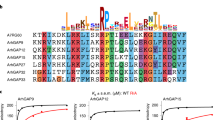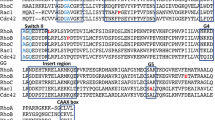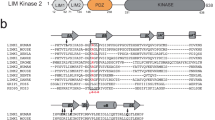Abstract
The small Ras-related GTPase, TC10, has been classified on the basis of sequence homology to be a member of the Rho family. This family, which includes the Rho, Rac and CDC42 subfamilies, has been shown to regulate a variety of apparently diverse cellular processes such as actin cytoskeletal organization, mitogen-activated protein kinase (MAPK) cascades, cell cycle progression and transformation. In order to begin a study of TC10 biological function, we expressed wild type and various mutant forms of this protein in mammalian cells and investigated both the intracellular localization of the expressed proteins and their abilities to stimulate known Rho family-associated processes. Wild type TC10 was located predominantly in the cell membrane (apparently in the same regions as actin filaments), GTPase defective (75L) and GTP-binding defective (31N) mutants were located predominantly in cytoplasmic perinuclear regions, and a deletion mutant lacking the carboxyl terminal residues required for post-translational prenylation was located predominantly in the nucleus. The GTPase defective (constitutively active) TC10 mutant: (1) stimulated the formation of long filopodia; (2) activated c-Jun amino terminal kinase (JNK); (3) activated serum response factor (SRF)-dependent transcription; (4) activated NF-κB-dependent transcription; and (5) synergized with an activated Raf-kinase (Raf-CAAX) to transform NIH3T3 cells. In addition, wild type TC10 function is required for full H-Ras transforming potential. We demonstrate that an intact effector domain and carboxyl terminal prenylation signal are required for proper TC10 function and that TC10 signals to at least two separable downstream target pathways. In addition, TC10 interacted with the actin-binding and filament-forming protein, profilin, in both a two-hybrid cDNA library screen, and an in vitro binding assay. Taken together, these data support a classification of TC10 as a member of the Rho family, and in particular, suggest that TC10 functions to regulate cellular signaling to the actin cytoskeleton and processes associated with cell growth.
This is a preview of subscription content, access via your institution
Access options
Subscribe to this journal
Receive 50 print issues and online access
$259.00 per year
only $5.18 per issue
Buy this article
- Purchase on Springer Link
- Instant access to full article PDF
Prices may be subject to local taxes which are calculated during checkout











Similar content being viewed by others
References
Buß F, Temm-Grove C, Henning S and Jockusch BM. . 1992 Cell Motil. Cytoskel. 22: 51–61.
Cahill MA, Janknecht R and Nordheim A. . 1996 Curr. Biol. 6: 16–19.
Chant J and Stowers L. . 1995 Cell 81: 1–4.
Clark GJ, Cox AD, Graham SM and Der CJ. . 1995 Meth. Enzymol. 255: 395–412.
Drivas GT, Shih A, Coutavas EE, Rush MG and D'Eustachio P. . 1990 Mol. Cell. Biol. 10: 1793–1798.
Evangelista M, Blundell K, Longtine S, Chow CJ, Adames N, Pringle JR, Peter M and Boone C. . 1997 Science 276: 118–122.
Galang CK, Garcia-Ramirez J, Solski PA, Westwick JK, Der CJ, Neznanov NN, Oshima RG and Hauser CA. . 1996 J. Biol. Chem. 271: 7992–7998.
Gauthier-Rouviere C, Vignal E, Mérianne M, Roux P, Montcourier P and Fort P. . 1998 Mol. Biol. Cell. 9: 1379–1394.
Hall A. . 1998 Science 279: 509–514.
Hart MJ, Eva A, Zangrilli D, Aaronson SA, Evan T, Cerione RA and Zheng Y. . 1994 J. Biol. Chem. 269: 62–65.
Johansen F-E and Prywes R. . 1995 Biochim. Biophys. Acta 1242: 1–10.
Joneson T, McDonough M, Bar-Sagi D and Van Aelst L. . 1996 Science 274: 1374–1376.
Kohno H, Tanaka K, Mino A, Umikawa M, Imamura H, Fujiwara T, Fujita Y, Hotta K, Qadota H, Watanabe T, Ohya Y and Takai Y. . 1996 EMBO J. 15: 6060–6068.
Lamarche N, Tapon N, Stowers L, Burbelo PD, Aspenström P, Bridges T, Chant J and Hall A. . 1996 Cell 87: 519–529.
Machesky LM and Hall A. . 1996 Trends Cell Biol. 6: 304–310.
Mackay DJG and Hall A. . 1998 J. Biol. Chem. 273: 20685–20688.
Murphy GA, Moore MS, Drivas GT, Villamarin A, D'Eustachio P and Rush MG. . 1997 Mol. Biol. Cell. 12: 2591–2604.
Neudauer CL, Joberty G, Tatsis N and Macara IG. . 1998 Curr. Biol. 8: 1151–1160.
Olson MF, Ashworth A and Hall A. . 1995 Science 269: 1270–1272.
Perona R, Montaner R, Saniger L, Samchez-Perez I, Bravo R and Lacal JC. . 1997 Genes Dev. 11: 463–475.
Reinhard M, Giehl K, Abel K, Haffner C, Jarchau T, Hoppe V, Jockusch BM and Walter U. . 1995 EMBO J. 14: 1583–1589.
Ren M, Villamarin A, Shih A, Coutavas E, Moore MS, LoCurcio M, Clarke V, Oppenheim JD, D'Eustachio P and Rush MG. . 1995 Mol. Cell. Biol. 15: 2117–2124.
Ren Y, Li R, Zheng Y and Busch H. . 1998 J. Biol. Chem. 273: 34954–34960.
Rothkegel M, Mayboroda O, Rohde M, Wucherpfennig C, Valenta R and Jockusch BM. . 1996 J. Cell. Sci. 109: 83–90.
Schulze-Osthoff K, Ferrari D, Riehemann K and Wesselborg S. . 1997 Immunobiol. 198: 35–49.
Sohn RH and Goldschmidt-Clermont P. . 1994 BioEssays 16: 465–472.
Suetsugu S, Miki H and Takenawa T. . 1998 EMBO J. 17: 6516–6526.
Tapon N and Hall A. . 1997 Curr Opin. Cell Biol. 9: 86–92.
Vojtek A and Cooper JA. . 1995 Cell 82: 527–529.
Wasylyk B, Hagman J and Gutierrez-Hartmann A. . 1998 Trends Biochem. Sci. 23: 213–216.
Westwick JK, Lambert QT, Clark G, Symons M, Van Aelst L, Pestell RG and Der CJ. . 1997 Mol. Cell. Biol. 17: 1324–1335.
Westwick JK, Lee RJ, Lambert QT, Symons M, Pestell RG, Der CJ and Whitehead IP. . 1998 J. Biol. Chem. 273: 16739–16747.
Whitehead IP, Abe K, Gorski JL and Der CJ. . 1998 Mol. Cell. Biol. 18: 4689–4697.
Widada JS, Ferraz C and Liautard JP. . 1989 Nucl. Acids Res. 17: 2855.
Zheng Y, Olson MF, Hall A, Cerione RA and Toksoz D. . 1995 J. Biol. Chem. 270: 9031–9035.
Zhou K, Wang Y, Gorski JL, Nomura N, Collard J and Bokoch GM. . 1998 J. Biol. Chem. 273: 16782–16786.
Zigmond SH. . 1996 Curr. Opin. Cell Biol. 8: 66–73.
Zohn IM, Campbell SL, Khosravi-Far R, Rossman KL and Der CJ. . 1998 Oncogene 17: 1415–1438.
Acknowledgements
We would like to thank Dr Angus Wilson for the pCGT vector, Dr Mindong Ren for the JNK constructs, Dr Shubha Bagrodia for the mPAK3-PBD (CRIB domain) construct, Dr Danny Manor for the CDC42 61L expression construct and Dr Isabel Novoa for many helpful discussions. This work was supported by Grant CB-100 from the American Cancer Society (MGR) and Grants CA42978, CA55008 and CA63071 (CJD). G Murphy was supported by PHS Training Grant GM07827 and P Pérez by a fellowship from the Ministerio de Educación y Ciencia, Spain. Computer work was carried out at the Research Computer Resource of New York University Medical Center, supported by NSF Grant DIR-8908095.
Author information
Authors and Affiliations
Rights and permissions
About this article
Cite this article
Murphy, G., Solski, P., Jillian, S. et al. Cellular functions of TC10, a Rho family GTPase: regulation of morphology, signal transduction and cell growth. Oncogene 18, 3831–3845 (1999). https://doi.org/10.1038/sj.onc.1202758
Received:
Revised:
Accepted:
Published:
Issue Date:
DOI: https://doi.org/10.1038/sj.onc.1202758
Keywords
This article is cited by
-
Macrophage mediated recognition and clearance of Borrelia burgdorferi elicits MyD88-dependent and -independent phagosomal signals that contribute to phagocytosis and inflammation
BMC Immunology (2021)
-
TC10 regulates breast cancer invasion and metastasis by controlling membrane type-1 matrix metalloproteinase at invadopodia
Communications Biology (2021)
-
RHOQ is induced by DLL4 and regulates angiogenesis by determining the intracellular route of the Notch intracellular domain
Angiogenesis (2020)
-
Inhibition of the mevalonate pathway enhances cancer cell oncolysis mediated by M1 virus
Nature Communications (2018)



